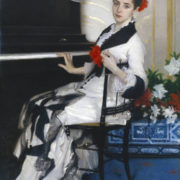Highlights from Fayez S. Sarofim Collection at the Museum of Fine Arts, Houston




 +4
+4 Highlights from Fayez S. Sarofim Collection at the Museum of Fine Arts, Houston
Highlights from Fayez S. Sarofim Collection at the Museum of Fine Arts, Houston
Highlights from Fayez S. Sarofim Collection at the Museum of Fine Arts, Houston
Highlights from Fayez S. Sarofim Collection at the Museum of Fine Arts, Houston
Highlights from Fayez S. Sarofim Collection at the Museum of Fine Arts, Houston
Highlights from Fayez S. Sarofim Collection at the Museum of Fine Arts, Houston
Highlights from Fayez S. Sarofim Collection at the Museum of Fine Arts, Houston

Intown readers are running out of time to see “Three Centuries of American Art – Antiquities, European, and American Masterpieces from the Fayez S. Sarofim Collection” at the Museum of Fine Arts, Houston. This marvelous exhibition ends September 6, 2021.
Cairo-born, Harvard-educated Houston collector and philanthropist Fayez S. Sarofim began purchasing art in 1961. Today his collection ranks as one of the most significant in private hands.
Its breath and depth are startling. You will see Egyptian antiquities, Coptic textiles, Navajo blankets, and works by artists as diverse as Lucas Cranach, El Greco, Eugène Delacroix, Pablo Picasso, Joaquín Torres-García, John Singleton Copley, Mary Cassatt, Arshile Gorky, Lucian Freud, Winslow Homer, Robert Motherwell, John Singer Sargent, Joan Mitchell and Robert Rauschenberg. There are many more.
At the end of fiscal year 2020, MFAH had assets totaling $1.83 billion, despite the pandemic losses that inspired the museum to term its dismal fiscal year an “annus horribilis,” borrowing the regal manner of Her Majesty Queen Elizabeth and other bigwigs who endure significant losses. Mr. Sarofim is partially responsible for the whopping endowment that sustained these losses due to the fact that Sarofim’s investment firm Sarofim & Co. oversees “growing” the museum’s money. Sarofim also manages the portfolios of Rice University, University of Houston, MD Anderson Cancer Center, Memorial Hermann Hospital, the Menil Foundation, the Brown Foundation and the Houston Endowment. And, naturally he forks over large amounts of money to the museum.
Director Gary Tinterow said the scope, scale and quality of this collection makes it almost unique. He believes the discipline that characterizes Sarofim’s investment strategy also colors his art collecting. Sarofim chooses brilliantly and holds for the long term.
Accompanying this exhibition of over 200 works is a fully illustrated catalogue, “Masterpieces from the Fayez S. Sarofim Collection: From Antiquity to Abstraction,” written by the Museum’s curatorial staff. It includes an informative introduction by Tinterow. Tinterow’s narrative provides a revealing peek into a collector compelled to “convert some of his personal profits into an art collection.”
Quoted by Tinterow, gallerist Fredericka Hunter who sometimes sold to Sarofim offered a glimpse of the man’s cultured and sensitive nature. “He had a cultured passion for things. He was a deep humanist. And he was relaxed about art, he liked the energy of it: it was part of his life, something to be enjoyed, and a break from his work.”
The curators’ work helps catalogue readers understand a lot of which inspired Sarofim to snatch these artworks. How could he resist the exquisite colors in the abstract painting “Then, Last Time, I” (1985) by American artist Joan Mitchell (1925-1992). Mitchell painted it while living in Vétheuil, where Monet lived from 1878 to 1881. The paintings Mitchell made in Vétheuil were inspired by the same landscape elements that excited Monet. In between boozing, Mitchell incorporated the colors of the sky and water and poppy fields into her painting. Sarofim responded to this.
Of for that matter, how could Sarofim not rope in John Singer Sargent’s exquisite portrait “Madame Ramón Subercaseaux,” (c. 1880–81.) “At the time of this portrait, Amalia Subercaseaux was twenty years old and recently married. Sargent portrayed her seated in an ebonized chair in front of a black piano inside her fashionable Parisian apartments on the Avenue du Bois de Boulogne. The clothing and furnishings, notably her elegant black and white organza dress and the blue and white porcelain jardinière, reflect her refined taste,” the catalogue informs you.
Years ago, I had the chance to tour some of Sarofim’s collection with a small group of people. We saw only a portion of his art, but I knew I had seen something very fine. This guy is grinding, I thought, maybe he can help me grow my money. Stupidly, I called Sarofim’s office to enquire about that. The person who answered was kind enough not to laugh at me while explaining my portfolio was way too puny.






































